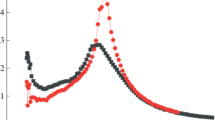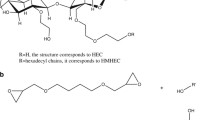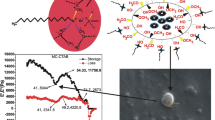Abstract
The inverse-gelation of methylcellulose (MC) is statistically understood for the loop formation, in which trans and gauche conformation are simultaneous. The dynamic light scattering (DLS) studies are performed to understand the temperature-dependent multiple scattering for a dilute solution of MC in an aqueous medium. These conformations further grow to form an entangled network, with a scattered size of 1.7 µm (an average hydrodynamic size) at 75 °C. The area under the light scattered curves at various temperatures is measured to calculate the energies involved in the gelation process. In the view of Maxwell Boltzmann's statistical, the active spheres are the number of sites that interconnect with probability 'α' to form a gel. The 'α' is maximum at the gel point, where all Cayley spheres merged to create a 3D network. The computational studies reveal that entanglement depends on the orientation of MC molecules and non-neighboring intramolecular H bonding (hydrogen bonding). The periodic box of 32 Å and 24 MC surrounded by water molecules suggest a hydrodynamic length of 5.5 nm (diagonal of the periodic box).












Similar content being viewed by others
References
Tanaka F (2000) Thermoreversible Gelation Strongly Coupled to Polymer Conformational Transition. Macromolecules 33:4249–4263. https://doi.org/10.1021/ma00092a039
Burchard W (1985) Networks in nature. Br Polym J 17:154–163. https://doi.org/10.1002/pi.4980170213
Clark AH, Ross-Murphy SB (1985) Structural and mechanical properties of biopolymer gels. Adv Polym Sci 83:57–192. https://doi.org/10.1007/BFb0023332
Singh RP, Kundu PP (2019) Studies on Rheological Thermal and Morphological Properties of Methylcellulose Gel in Aqueous Medium. Polym Eng Sci 59:2024–2031. https://doi.org/10.1002/pen.25202
Flory PJ (1941) Molecular Size Distribution in Three Dimensional Polymers I Gelation. J Am Chem Soc 63:3086–3091. https://doi.org/10.1021/ja01856a061
Flory PJ (1941) Molecular Size Distribution in Three Dimensional Polymers II Trifunctional Branching Units. J Am Chem Soc 63:3091–3096. https://doi.org/10.1021/ja01856a062
Stockmayer WH (1943) Theory of molecular size distribution and gel formation in branched polymers II General cross linking. J Chem Phys 11:45–55. https://doi.org/10.1063/1.1723803
Singh RP, Kundu PP (2008) Thermogelation of Methylcellulose From Solution in N, N-Dimethylformamide and Characterization of the Transparent Gels. J App Polym Sci 110:3031–3037. https://doi.org/10.1002/app.28527
Kundu PP, Singh RP (2008) Effect of Addition of Surfactants on the Rheology of Gels from Methylcellulose in N, N-Dimethylformamide. J App Polym Sci 108:1871–1879. https://doi.org/10.1002/app.27839
Singh RP, Kundu PP (2018) Rheological and Micro Structural Studies of Methylcellulose Solutions in N, N Dimethylformamide for preparation of Extruded beads Controlled Urea release. Rheol Acta 57:169–179. https://doi.org/10.1007/s00397-017-1066-4
Singh RP, Kundu PP (2013) Rheological Properties of the Methylcellulose Gels in N, N, Dimethyl Formamide Validity of Scaling Laws. Polym Sci Series A 55:455–462. https://doi.org/10.1134/S0965545X13070092
Singh RP, Kundu PP (2013) DSC and micro structural studies of methylcellulose gels in N, N Dimethylformamide. J Polym Res 20:226–237. https://doi.org/10.1007/s10965-013-0226-1
Singh RP, Kumari K, Kundu PP (2013) Controlled Release of Urea Through Mesoporous Methylcellulose Films Derived From N, N Dimethyl Formamide. Int J Polyme Mater Polym Biomater 62:755–762. https://doi.org/10.1080/00914037.2013.769238
Hirrien M, Hevillard C, Desbrieres J, Axelos MAV, Rinaudo M (1998) Thermogelation of methylcelluloses new evidence for understanding the gelation mechanism. Polymer 39:6251–6259. https://doi.org/10.1016/S0032-3861(98)00142-6
Li L, Thangamathesvaran PM, Yue CY, Tam KC, Hu X, Lam YC (2001) Gel Network structure of methylcellulose in water. Langmuir 17:8062–8068. https://doi.org/10.1021/la010917r
Tanaka F, Nishinari K (1996) Junction multiplicity in thermoreversible gelation. Macromolecules 29:3625–3628. https://doi.org/10.1021/ma951577h
Tanaka F, Ishida M (1995) Thermoreversible gelation of hydrated polymers. J Chem Soc Fara Trans 91:2663–2670. https://doi.org/10.1039/FT9959102663
Suzuki K, Taniguchi Y, Enomoto T (1972) The effect of pressure on the sol-gel transformations of macromolecules. Bull Chem Soc Japan 45:336–338
Takahashi M, Shimazaki M (2001) Formation of junction zones in thermoreversible methylcellulose gels. J Polym Sci B Polym Phys 39:943–946. https://doi.org/10.1002/polb.1069
Lott JR, McAllister JW, Arvidson SA, Bates FS, Lodge TP (2013) Fibrillar structure in aqueous methylcellulose solutions and gels. Biomacromol 14:2484–2488. https://doi.org/10.1021/bm400694r
Schmidt PW, Morozova S, Owens PM, Adden R, Li Y, Bates FS, Lodge TP (2018) Molecular Weight Dependence of Methylcellulose Fibrillar Networks. Macromolecules 51:7767–7775. https://doi.org/10.1021/acs.macromol.8b01292
Schmidt PW, Morozova S, Ertem SP, Coughlin ML, Davidovich I, Talmon Y, Reineke TM, Bates FS, Lodge TP (2020) Internal Structure of Methylcellulose Fibrils. Macromolecules 53:398–405. https://doi.org/10.1021/acs.macromol.9b01773
Huggins M (1942) Some Properties of Solutions of Long-chain Compounds. J Chem Phys 46:151–157. https://doi.org/10.1021/j150415a018
McAllister JW, Schmidt PW, Dorfman KD, Lodge TP, Bates FS (2015) Thermodynamics of Aqueous Methylcellulose Solutions. Macromolecules 48:7205–7215. https://doi.org/10.1021/acs.macromol.5b01544
Tanaka F (2006) Thermoreversible gelation is a Bose-Einstein condensation. Phys Rev E 73:061405. https://doi.org/10.1103/PhysRevE.73.061405
Yu H, Amann M, Hansson T, Köhler J, Wich G, van Gunsteren WF (2004) Effect of Methylation on the Stability and Solvation Free Energy of Amylose and Cellulose Fragments: A Molecular Dynamics Study. Carb Res 339:1697–1709. https://doi.org/10.1016/j.carres.2004.05.003
Huang W, Ramesh R, Jha PK, Larson RGA (2016) Systematic Coarse-Grained Model for Methylcellulose Polymers: Spontaneous Ring Formation at Elevated Temperature. Macromolecules 49:1490–1503. https://doi.org/10.1021/acs.macromol.5b02373
Davidson N (1962) Statistical Mechanics, Chapter 5. McGraw-Hill Book Company Inc, New York, pp 64–76
Singh RP (2021) Rheological and Conformational Studies of Methylcellulose Gels in an Aqueous Medium. Polym Sci Ser A 63(3):252–259. https://doi.org/10.1134/S0965545X21030111
Zheng T, Bott S, Huo Q (2016) Techniques for Accurate Sizing of Gold Nanoparticles Using Dynamic Light Scattering with Particular Application to Chemical and Biological Sensing Based on Aggregate Formation. ACS Appl Mater Interfaces 8:21585–21594. https://doi.org/10.1021/acsami.6b06903
da Silva MN, de Matos FJ, Feldhaus HK, Soares LS, Valencia GA, de Campos CEM, Di Luccio M, Monteiro AR (2019) Physical and morphological properties of hydroxypropyl methylcellulose films with curcumin polymorphs. Food Hydrocol 97:105217. https://doi.org/10.1016/j.foodhyd.2019.105217
Acknowledgements
The authors would like to thank the principal of GSSDGS Khalsa College, Patiala, for the partial financial assistance (KCP/2020-21/MS/4516), Director SLIET Langowal for using HyperChem 8 Malvern Instruments Ltd. for DLS characterization.
Author information
Authors and Affiliations
Corresponding author
Ethics declarations
Conflict of Interest
The author has received a partial research grant in executing this research work KCP/2020–21/MS/4516. Therefore, I, an author, declare that I don't have any conflict of interest.
Additional information
Publisher's Note
Springer Nature remains neutral with regard to jurisdictional claims in published maps and institutional affiliations.
Rights and permissions
About this article
Cite this article
Singh, R.P. Temperature-dependent dynamic light scattering studies on dilute aqueous solution of methylcellulose. J Polym Res 29, 62 (2022). https://doi.org/10.1007/s10965-022-02917-7
Received:
Accepted:
Published:
DOI: https://doi.org/10.1007/s10965-022-02917-7




